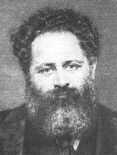Berthold Hatschek

Berthold Hatschek (3 April 1854 – 18 January 1941) was an Austrian zoologist remembered for embryological and morphological studies of invertebrates.
He studied zoology in Vienna under Carl Claus (1835-1899), and in Leipzig with Rudolf Leuckart (1822-1898). He gained his doctorate at the University of Leipzig with a dissertation titled Beiträge zur Entwicklungsgeschichte der Lepidopteren. Hatschek was deeply influenced by the works of Ernst Haeckel (1834-1919).
In 1885 he was appointed professor of zoology at Charles University in Prague, and from 1896 was a professor and director of the second zoological institute at the University of Vienna. Hatschek suffered from severe depression, which greatly affected his work in the latter stages of his life.[1][2]
Hatschek is remembered for the so-called "trochophore theory", in which he explains the trochophore to be the larval form of a hypothetical organism- the "trochozoon" (which in adult form corresponded to a trochophore-like rotifer, and was the suggested common ancestor of almost all bilateral, metazoan lifeforms).[3][4]
In 1888 he split Frey and Leuckart's Coelenterata into three phyla: Spongiaria, Cnidaria and Ctenophora.[5][6] From his research of amphioxus, the anatomical terms- "Hatschek's pit" and "Hatschek's nephridium" are derived.[7]
Selected writings
- Studien über Entwicklungsgeschichte der Anneliden. Ein Beitrag zur Morphologie der Bilaterien, 1878
- Studien über entwicklung des Amphioxus, 1881
- Lehrbuch der Zoologie : eine morphologische Übersicht des Thierreiches zur Einführung in das Studium dieser Wissenschaft, 1888
- "The Amphioxus and its development", translated into English- 1893
- Das acromerit des Amphioxus, 1906
- Das neue Zoologische System, 1911.[8]
References
- ↑ Austria-Lexicon (biography)
- ↑ Deutsche Biographie
- ↑ Biology Of Helminthes By D.R. Khanna
- ↑ Dictionary of Developmental Biology and Embryology by Frank J. Dye
- ↑ Gulf of Mexico Origin, Waters, and Biota: Biodiversity, Volume 1 by Darryl L. Felder, Sylvia A. Earle
- ↑ The demise of Coelenterata and Madreporaria by J. van der Land
- ↑ Biologists.org The Early Development of the Nephridia in Amphioxus: Introduction and Part I, Hatschek's Nephridium. by Edwin S. Goodrich, F.R.S
- ↑ WorldCat Identities (bibliography)